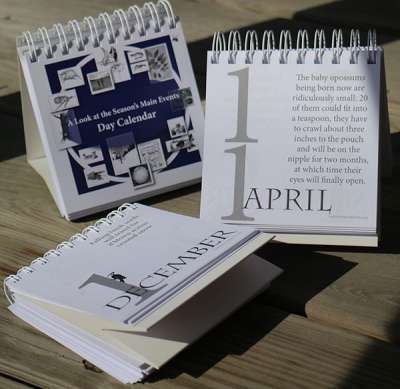As I write this I’m listening to a tractor trailer back up to the office; it’s here to deliver the first shipment of our new seasonal nature calendars. I have a sample on my desk, and at the risk of sounding like a shameless self-promoter, I have to say that it’s a handsome product. Simple, clean, retro. Three hundred and sixty five little squares, each containing one of Ginny Barlow’s fabulous nature observations that allow us to remember, while we sit at our desks, what’s going on outside. I especially like that there’s no mention of cultural milestones: that on March 17, male striped skunks are prowling and covering a lot of territory – “unless they get hit by cars, as they often do;” that July 4 is simply a day when whirligig beetles are feeding on small worms and midge larvae. It’s not that I have anything against St. Patrick’s Day and the Fourth of July, I just like the idea of a document that focuses on the world besides us.
The whole exercise caused me to look at my regular calendar and pay attention to the little words that denote cultural phenology. There are a lot of Christian and Jewish holidays mentioned, though Ramadan and Kwanzaa also get nods. There are the patriotic staples: Presidents’, Columbus, the Memorials. Earth Day gets noted on this particular calendar, which seems nice, as do the solstices, but otherwise there’s nothing nature-themed, unless you can count strange-old Halloween, our one major holiday that has nothing do with war, forefathers, or modern religion. Since the holiday traces its roots back to pre-enlightenment seasonal rhythms, one could make the case that Halloween, in an abstract way, is a place where the cultural and natural calendar come together.
According to my Irish grandfather and the Internet, Halloween originated as an ancient Celtic harvest festival. November 1 was the start of the Celtic winter, so on the night of the October 31, townsfolk would gather to revel around bonfires where they’d feast and drink and sacrifice crops and animals to vengeful deities. It was thought that on this night the boundary between the living and the dead blurred, allowing druids to confer with the otherworldly spirits who showed up and ask them for direction and prophesy.
This scenario seems a bit nuts in today’s literal-minded world, but the symbolism still resonates. Halloween falls at the transition between fall and winter, right about the time when gentle October autumn rears up and gnashes its teeth. It’s still the season of death for everyone who lives their life in a naturally attuned way. Whether it’s passively observing the hillsides break like stained glass windows, or actively sacrificing crops and animals for the winter larder, death this time of year is still inescapable and powerful and mystic. Late October is liminal, a word that doesn’t show up in some dictionaries but means that sort of dreamy space between things. In this case, seasons. Twilight would be considered liminal in that it’s not really day and it’s not really night. These dream spaces speak directly to our souls, which is why ancient peoples built religions around them and today’s writers and artists seek them out.



Discussion *